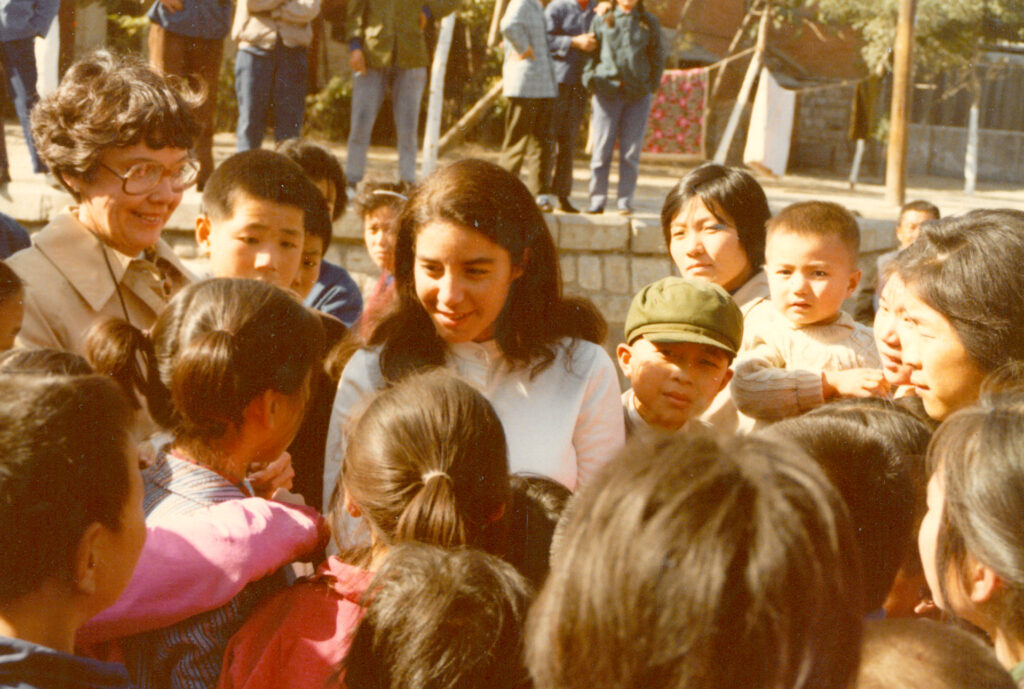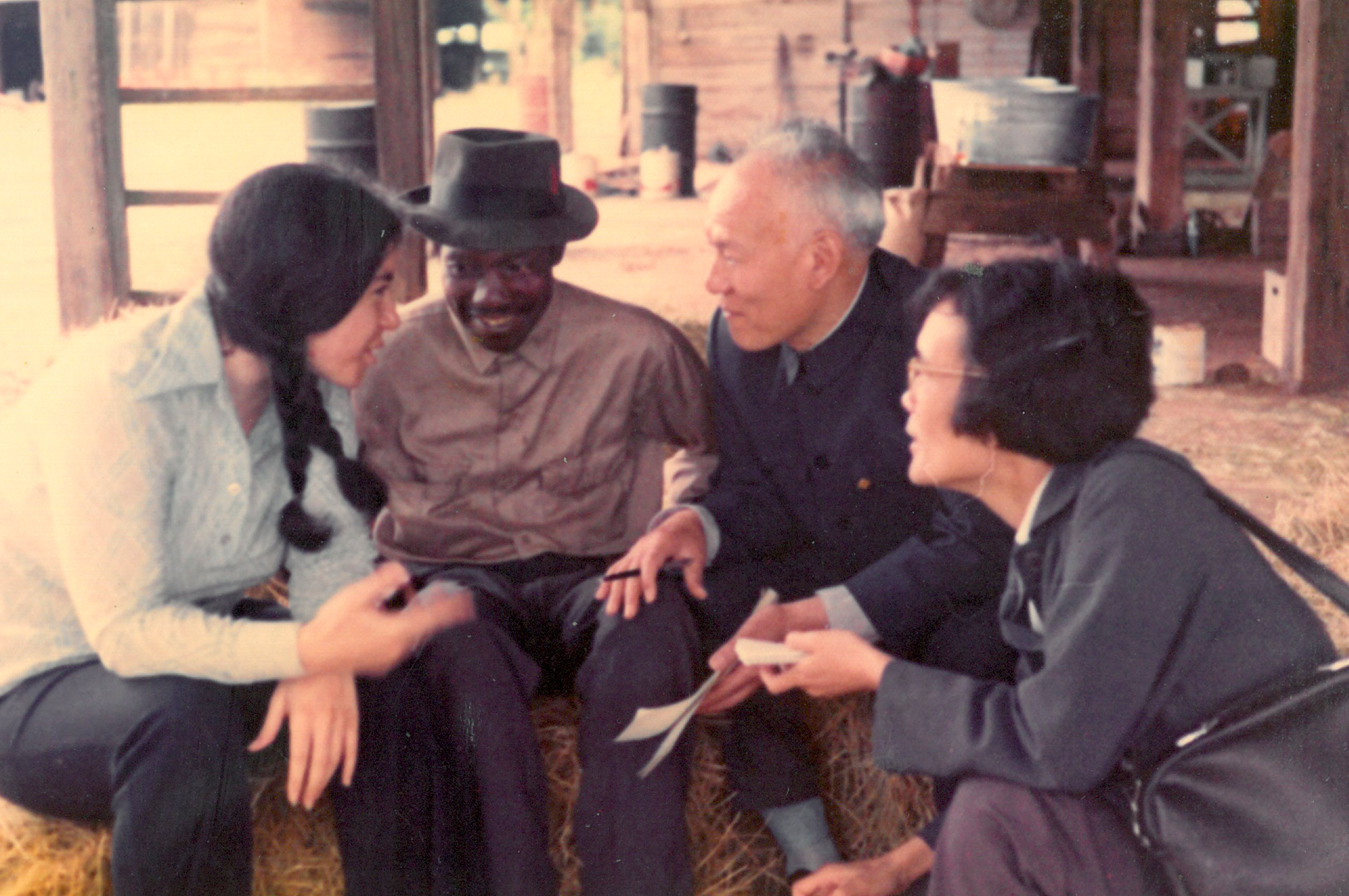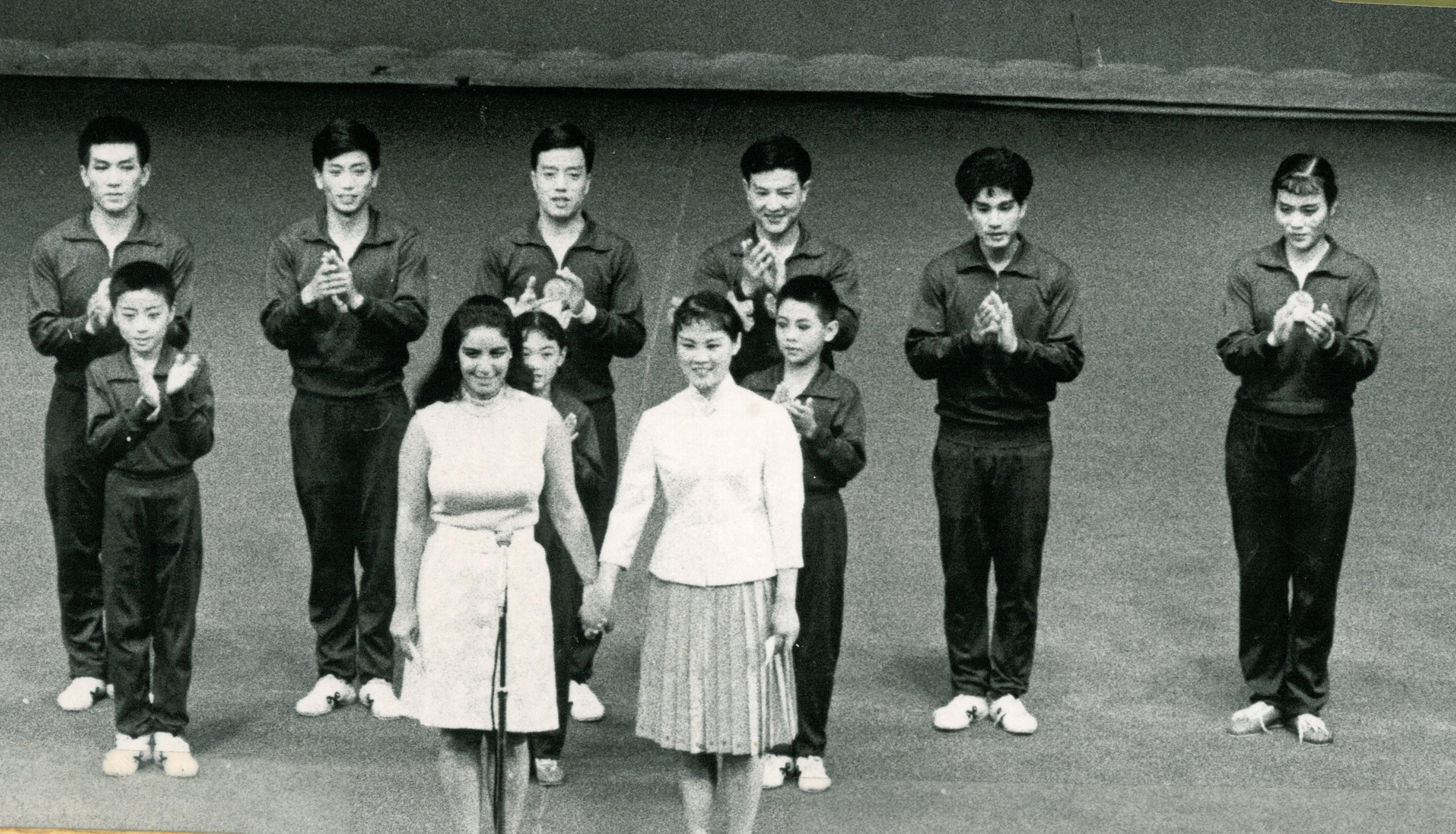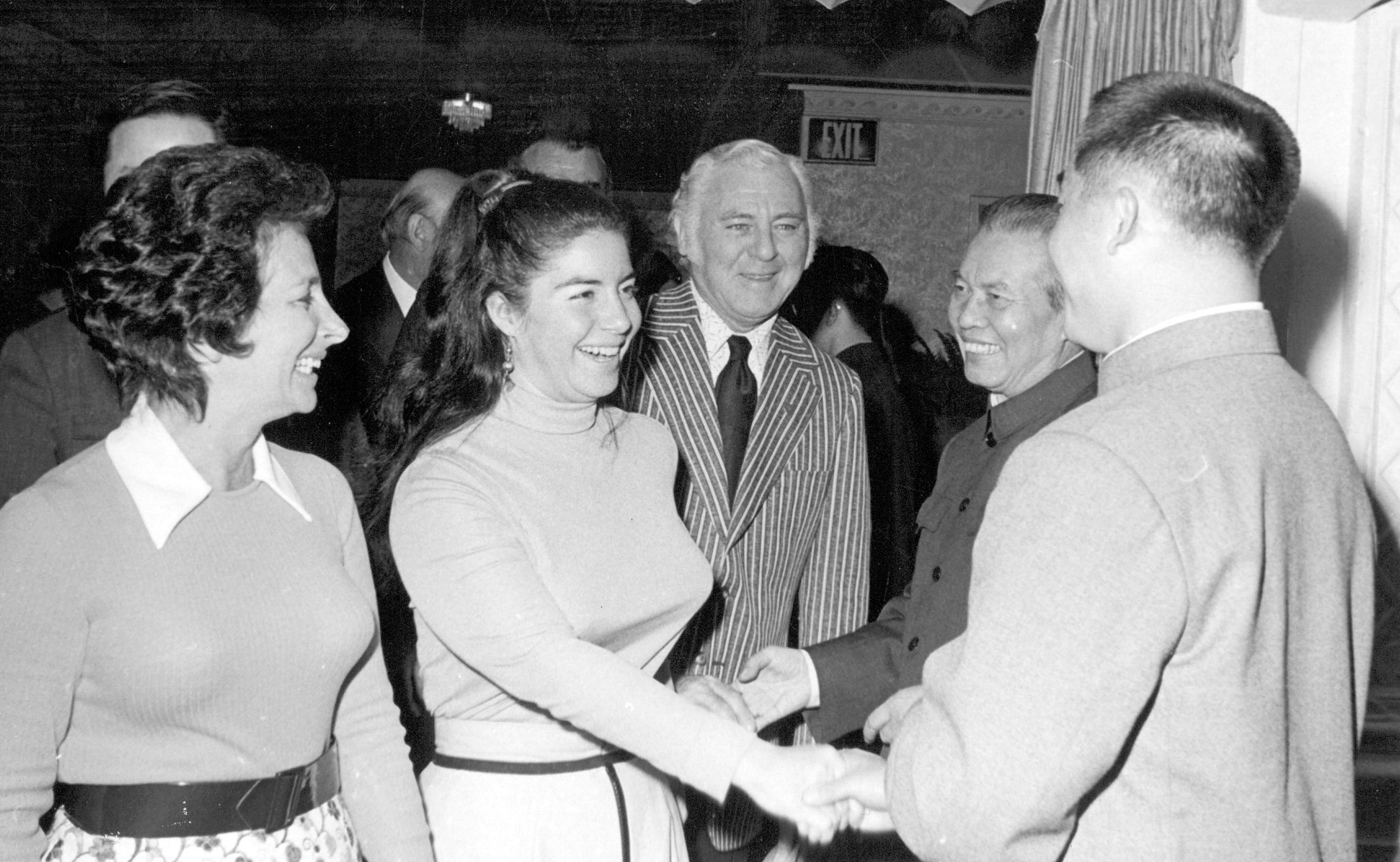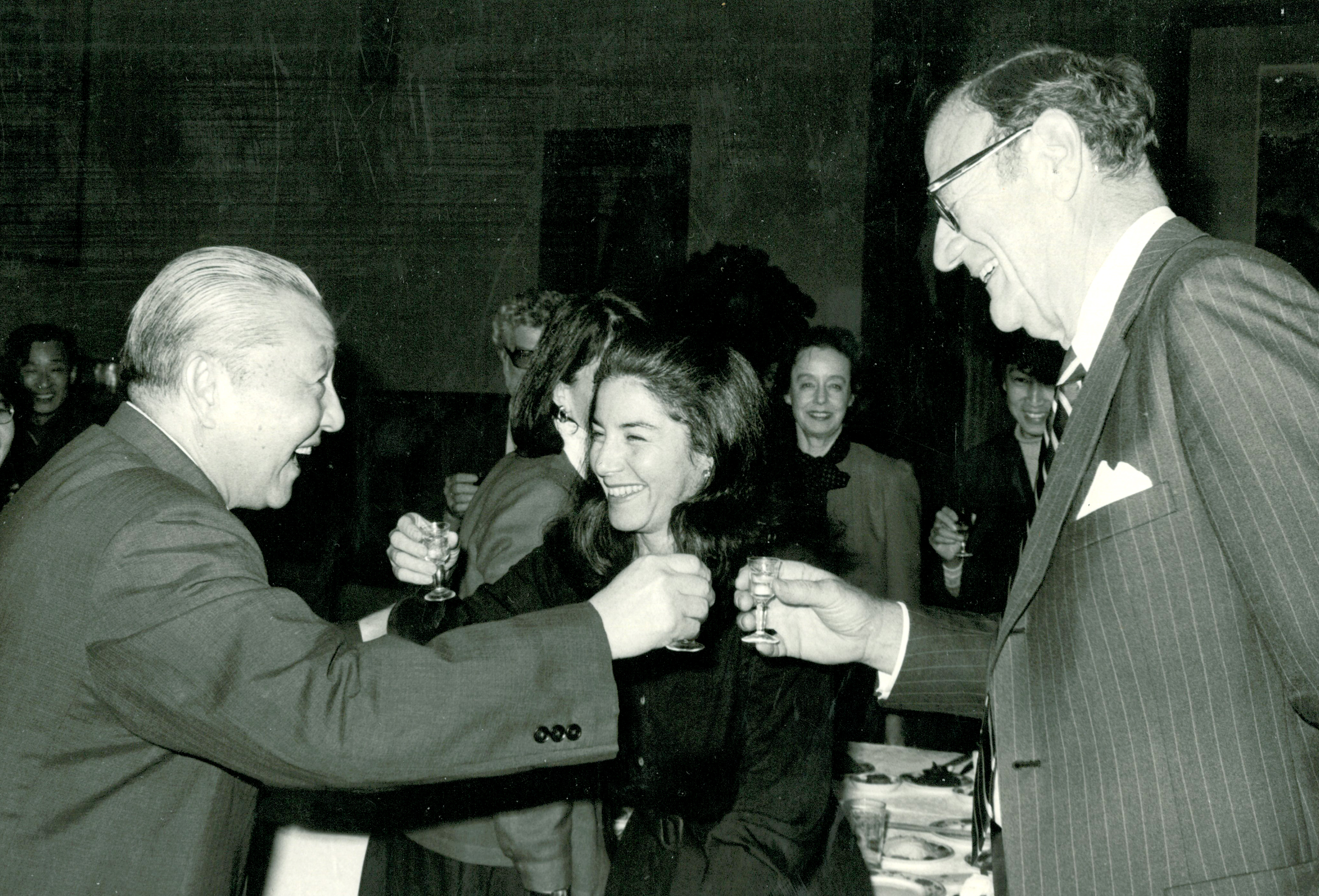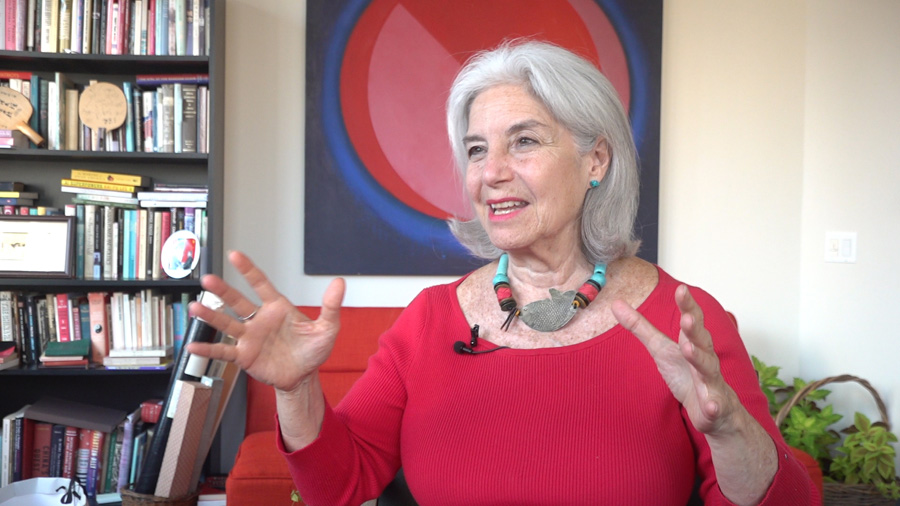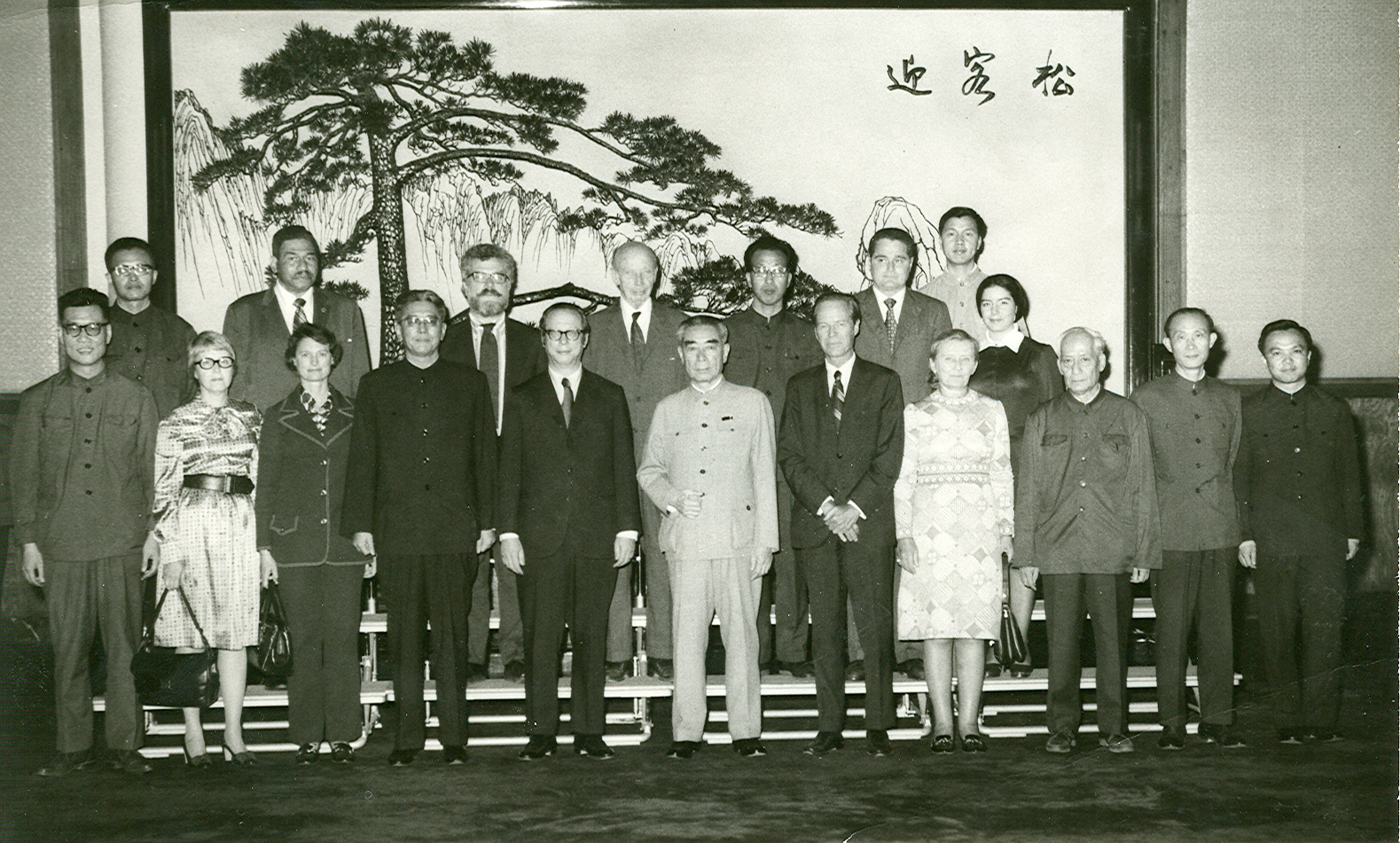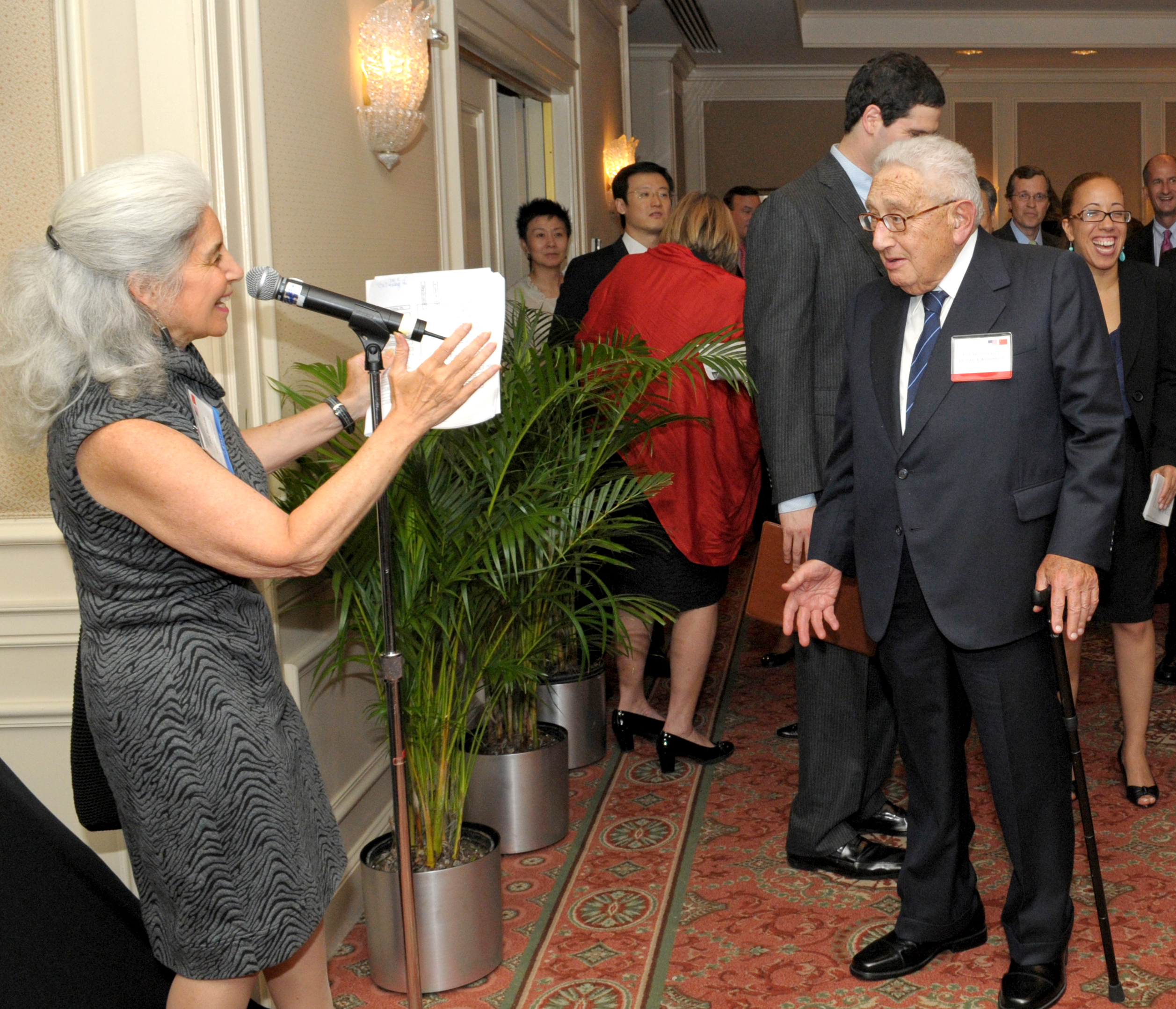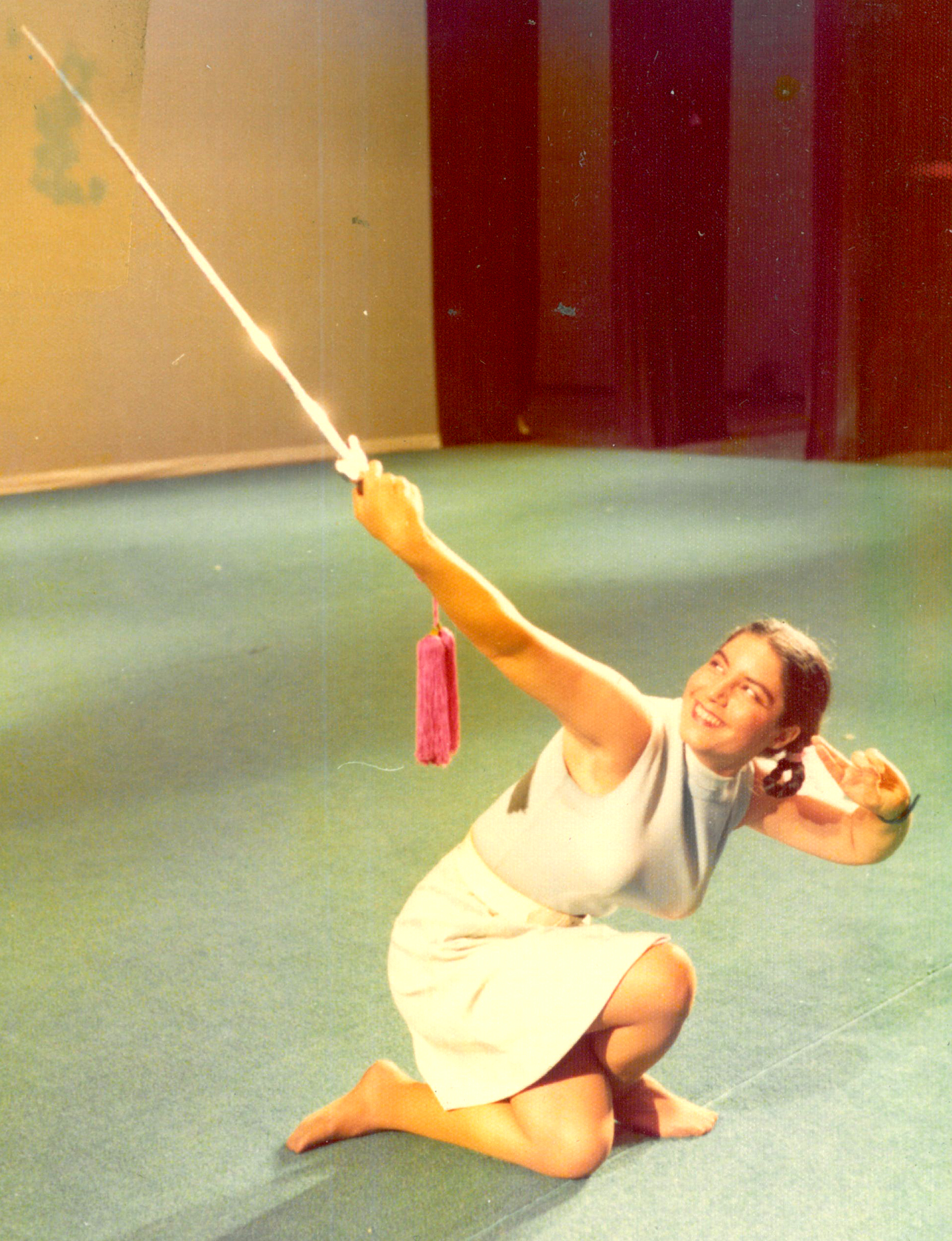By ZHAO XU in New York | China Daily | November 9, 2019
1973: On the streets of Beijing during a delegation of National Committee board members
When a junior U.S. diplomat decided to take temporary leave from her diplomatic post in Hong Kong 48 years ago, it barely dawned on her that a year would turn into a lifetime.
The curtain went down. The spotlight was on. Jan Berris, whose hair was in two braids, walked briskly onto the stage of the auditorium to announce the next item on the program.
The audience waited with bated breath, having just been treated to a riotous lion dance.
It was in Chicago in December 1972. The Shenyang Acrobatic Troupe from northeastern China was touring the United States, Chicago being its first stop.
And the braids, popular among Chinese young women at the time, were meant to be a nod to her Chinese counterpart on stage.
“All of a sudden I saw, out of the corner of my eye, that one of our security officers was running to the back of the auditorium,” Berris says.
“The bright stage lights were on so I couldn’t see clearly, but I could tell that there was some sort of commotion. The minute I walked off stage I said to our stage director: ‘Don’t pull up the curtain.'”
It turned out that someone in the audience had thrown a projectile spewing tear gas toward the stage, and as the acrid gas filled the auditorium it had to be evacuated.
“The event was co-hosted by the New York City Center and the National Committee on U.S.-China Relations, for which I was working,” Berris says.
1973: Interpreting for a Georgia farmer and members of the first Chinese Journalists Delegation to visit the United States
“So we went backstage to talk to the head of the Chinese delegation. We explained the situation and said: ‘It’s up to you as to whether you want to continue the show or not. If the answer is yes, we’ll wait for an hour before bringing back the audience; if it’s no, we’ll just miss this one performance and begin again tomorrow.’
After conferring briefly, they said: ‘Yes, we want to do it.'”
In the theater world there’s a saying for such situations, that “the show must go on,” Berris says.
“The Chinese decision was very much in that vein.”
Forty-eight years later, Berris, vice president of the National Committee on U.S.-China Relations in New York, was sitting in her office steps away from Times Square, reminiscing about a career that has provided her a front-row seat to chapters of history filled with drama and tumult.
“I used to look out of my office window into the Biltmore Hotel, a wonderful old hotel in New York. It was where the Shenyang acrobats and the Chinese martial arts team stayed…But before them it was the ping-pong team.”
For more than two weeks in April 1972 the Chinese Table Tennis Team toured the United States, visiting a number of cities and playing friendly matches. A year before, their American counterparts had been invited to visit China, the first American delegation since 1949.
Dubbed ‘ping-pong diplomacy,’ these mutual gestures symbolized a thaw in what was once seen as a perennially frozen relationship.
1974: Taking a bow with her Chinese co-announcer during the Wushu Team’s visit to the United States
In a fateful twist of events, it also set Berris, a promising young diplomat stationed in the U.S. consulate in Hong Kong, on a different path.
“In June 1971, two months after the U.S. players’ China visit, I was invited by a former professor of mine who was the chairman of the National Committee to join the organization and prepare for the coming visit for the Chinese ping-pong team. So I took what I thought would be a one-year leave from the foreign service.”
While the Chinese players were in the United States, they were followed around by “two plane loads of journalists,” says Berris, who was with the Chinese team throughout.
“Print journalists, television journalists…American media, Chinese media, Japanese media, the European media…It was a really, really big deal.”
The event was so successful that the acrobats were sent. Again, the National Committee was the host. Berris naturally asked for a second year’s leave, which was agreed to, and then a third year, which was also granted, albeit reluctantly. When the fourth year came, Berris, who then knew “more Chinese than all the people working for the U.S. government combined,” decided to resign from the foreign service and permanently join the Committee, founded in 1966 by people who “saw the potential not the limitations” in the two countries’ future.
“Looking back, it all sounds surreal for a girl growing up in a landlocked city in Michigan,” Berris says.
Most of the first generation of “China hands” had either missionary or trader ancestors who were involved with China, she says.
1972: During a reception hosted by PRC Ambassador to the UN Huang Hua (second right) honoring the Chinese Table Tennis Team’s visit to New York, Jan Berris (second left) and her parents meeting table tennis team captain Zhuang Zedong
Berris has neither. In fact her decision to focus on China studies at the University of Michigan was mostly fueled by an early interest in Hawaii, where large Chinese and Japanese populations live. “I’ve always wanted to study and learn about cultures different than my own,” says Berris, who concedes that “working for the Committee does give me a chance to call those who wrote my textbooks by their first names.”
These days Berris has become some sort of institutional memory for the National Committee, a fixture who has “survived on minimal sleep and the occasional can of tuna,” to quote one of her colleagues who eight years ago joined others to celebrate her 40th year with the Committee.
VIDEO: Celebrating 40 Years of Jan Berris: Tributes and Memories from Friends and Mentors
VIDEO: Additional Tributes to Jan Berris, on Her 40th Anniversary
Jay Henderson, a China expert and senior adviser to the China Global Philanthropy Institute in Beijing and Shenzhen, worked with Berris in the 1970s and ’80s and continues to be a close friend.
“She is an absolute whirlwind of action,” Henderson says. “I remember one occasion when we were trying to mail invitations to our 600-plus members for an event that was happening very soon. It was so close that we absolutely had to get the invitations in the mail that day…So she called me into her office and we sat on the floor to stuff the invitations into envelopes, lick them with our tongues and seal them.”
“We were doing this when Jan received a phone call from the CEO of a Fortune 500 company who wanted her advice on how to handle a sensitive situation with China. Without stopping or moving from the floor to her desk, she took the call and gave her best advice to the CEO, who never knew that she continued to stuff, lick and seal.”
1980: Xi Zhongxun (left) welcoming Lucian Pye (right) and Jan Berris during a NCUSCR board visit to China
In the mid-’90s Berris paid tribute to her early inspiration when she took a delegation of Chinese ethnic minority leaders to Hawaii. Robert Daly, the accompanying interpreter, tells of “the most tiring and glorious day” in his China career, when the group visited two islands and had four meetings before ending the day with a visit to a surfer’s home by the ocean, at the insistence of Berris.
“She taught everyone that this matters, that not a moment is to be wasted when we have a chance to get together.”
An even funnier story is told by June Mei, a Harvard graduate who served as an escort interpreter for many Chinese heads of state as well as visiting delegations from the mid-1970s onward.
“When the Chinese Performing Arts Company was here in the ’70s, a dancer came up to Jan after knowing that their performance would be filmed by PBS. She was quite anxious, saying that her front teeth tended to look yellow up-close,” Mei says.
So Berris and Mei went to visit a theatrical supply store. There they found not one, but a whole array of tooth paint, in different shades of white, from creamy to ivory to snow. Determined to find the most natural color, Berris tried all of them on her own front teeth, only to discover that they were there to stay.
“‘Tooth paint isn’t supposed to come off easily,’ the salesman told us. For the next few days Jan had to speak in a mumbling fashion and try her best not to smile at anyone. Jan really cares about people as people, not just for which institutions they represent or whether she agrees with their opinions.”
2019: Jan Berris in her office
For many who are familiar with Berris, her sincerity is always coupled with an unfailing attention to detail.
In the ’70s, most hotels didn’t yet have coffee makers in their rooms, and Berris, a legendary workaholic and multi-tasker, would drive her staff crazy by insisting that they carry electric tea kettles to whichever hotel rooms the Chinese delegation members were staying. She also went to great length to make sure the hotel chef knew how to make xifan, or Chinese rice soup, the way the Chinese would like to have it, with no butter or salt.
“Back then, the hotels were really excited to have the Chinese delegations staying, and the airlines agreed to fly us very inexpensively, or even for free,” she says.
“In 1972, before the ping-pong team left, the chef at the Biltmore Hotel made this giant sheet cake decorated with ping-pong balls and paddles, as well as the American and the Chinese flags. We never asked him to do that; it was purely his own way of welcoming the Chinese.”
Over the past half century, Berris has brought hundreds of Chinese delegations to the United States, in addition to traveling to China more than 160 times, taking with her various groups from governors, mayors, and a supreme court justice to business leaders, academics, and tennis players.
Her first trip to China was in 1973, when the young Berris met the Chinese premier Zhou Enlai.
“He’s one of those people that you meet in your lifetime, that you are so impressed with and find their character so charismatic and engaging that you don’t want to wash your hands for weeks after shaking their hands.”
1973: NCUSCR board members meeting with Chinese Premier Zhou Enlai (front row, sixth from left). Jan Berris is first right in the second row.
As a group photo was being taken, Zhou turned to her and said: “I understand that Miss Berris speaks Chinese. I wonder if she could translate for us the characters on the screen that we are standing in front of.”
Seized by nervousness, Berris was almost certain that she would embarrass herself until she looked back and realized, with great relief, that the words were exactly those she had been taught by one of her Chinese hosts at a welcoming dinner the previous night.
“It couldn’t be a pure coincidence,” she says.
Three years later in July 1976, Berris was staying with an American congressional staff delegation at the Beijing Hotel when an earthquake struck the city of Tangshan about 200 kilometers away. Today, the number of deaths is estimated at more than 243,000.
“I was shaken out of sleep at around 2:00 a.m. and thought that the Russian Bear was attacking,” she says, referring to the acrimonious relationship between China and Russia at the time.
“Eventually, we all ran down the 18 flights of steps and went out onto the sidewalk, where it was clear that one of the balconies of the hotel had partly cracked and fallen.”
“After the earthquake, for at least a year, a lot of people in Beijing moved from their damaged quarters onto the street, where they set up tents and shacks.”
2019: Speaking on a panel during NCUSCR’s inaugural U.S.-China Subnational Symposium in Ann Arbor, Michigan
In February 1979, one month after China and the United States normalized their relationship, Deng Xiaoping, the vice-premier, visited a number of U.S. cities. Berris was asked by the State Department to coordinate the Chinese media activities for the visit.
In Simonton, Texas, while watching a rodeo show, Deng symbolically donned a cowboy hat, wowing the world media present, including more than 30 journalists from China.
“It was a real surprise…Deng had the intuition to sense what would play well for the American public, and had the confidence to do it, ” says Berris, who had also organized the program for and traveled with Xi Zhongxun, the late father of the incumbent Chinese President, Xi Jinping, when he visited the United States in 1980, as the governor of Guangdong Province.
“He was a very thoughtful man,” says Berris, who calls herself “a strong believer in engagement and exchanges,” and who, at the end of Deng’s visit, arranged for a Chinese journalist to sing “Getting to Know You” from the 1950s American musical film The King and I, joined on stage by American security personnel involved in the landmark visit.
Only days before, there had been friction between the security men and the reporter as she, trying to get her job done, ignored certain security rules, to the great chagrin of the latter.
“Getting to know you, getting to like you, getting to hope you like me…this is really what I thought would be a lovely way to end something that had been difficult and intense for a while,” says Berris, who had taught the Chinese reporter the song.
2010: With Dr. Henry A. Kissinger at a dinner honoring Premier Wen Jiabao in New York
“Till recently there have always been people on both sides who felt that a strong, stable relationship between the two countries was paramount. Unfortunately the coalition is fraying and the relationship, at least on the governmental level, is spiraling downward at a dizzying rate. But I still believe in the importance of the relationship and that there are things that both sides could and should do.”
In the United States, the past 40 years of engagement are now being looked at in a revisionist way, she says.
“Some Americans feel that these engagements have been one sided and that it’s just the Chinese who have benefited from it, and I would argue strongly that this is not the case.
“What we are trying to do here at the National Committee is to work against this narrative that has somehow grown up. Engagement is essential for all of us. It must be done in a reciprocal, mutually beneficial and constructive way. But this idea of decoupling, of minimizing the amount of contact between the two peoples, is a path toward disaster.
“None of the people who had thought up and fought for and developed the policy of engagement between our two countries ever thought that China was going to become just like the United States.”
1974: Practicing her sword pose during the Chinese Wushu Team’s visit to the United States
Looking back on that “freezing cold night in Chicago,” Berris said most of the audience chose to stay instead of going home and having their ticket money refunded.
“When they were finally allowed back into the theater, there was only a faint whiff of the tear gas there. But it was a lot stronger upon the stage, where the acrobats were doing some very difficult tasks that require plenty of energy and therefore air into one’s body. They got a lot of credit from the audience and the media which reported on it afterwards.”
In April 1971 Berris was about to board a ferry in Kowloon, Hong Kong, when she saw a lot of newspapers being held up and hawked by various people. “The headlines said that the American ping-pong team was going to China. But I wouldn’t believe it until I got back to the office and everyone was running around in excitement.”
History is a string of surprises. Berris has witnessed many, and in some she has been one of the players.
She became so fond of everyone on the Chinese Table Tennis Team she had traveled with in 1972 that when it was time to say goodbye, amid a great swarm of reporters, she found herself trying to fight back tears-in vain.
“The next year when I visited China, people would come up to me and ask: ‘Are you that crying girl?'”
(Source: China Daily)
Click photo thumbnail to expand:
